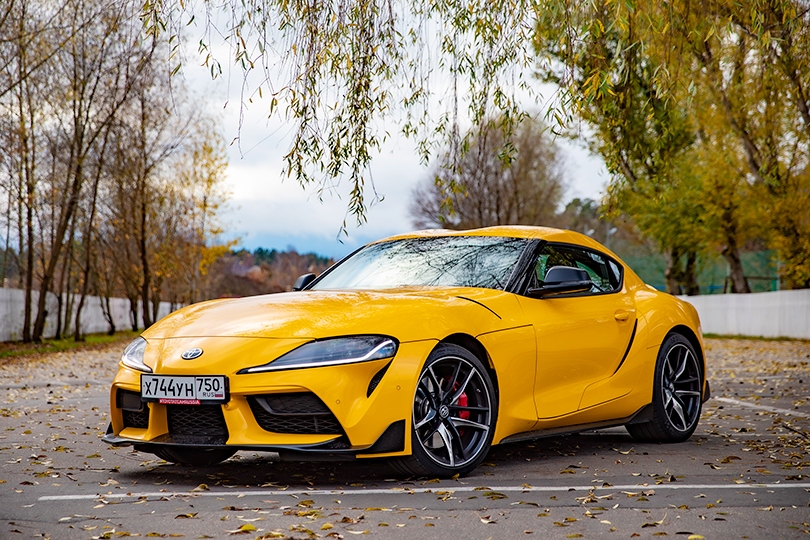The best sequels are often those that have kept you waiting for them, and Toyota has kept us waiting for a new Supra for a very, very long time. So it’s no surprise that the new car has generated lots of buzz and excitement, and I was eager as heck to drive it. Does the new GR Supra — Gazoo Racing in case you’re wondering — do its legendary badge justice?
It really has been a while since Toyota had a full blooded sportscar in their lineup. Seventeen years, to be exact. Sure, the GT86 has been around for a while now but that car isn’t exactly a Supra replacement with its fairly punchless 2 litre flat four engine. One thing the latest Supra does have in common with the GT86 is that Toyota has again gone for a shared platform with another manufacturer to lessen the financia burden of developing a car from scratch. The sportscar market, if you hadn’t noticed, isn’t exactly flourishing these days. So it makes sense for manufacturers to team up for development if they want to ever make any actual money selling low volume cars such as this.
![]()
Which brings us neatly to the large and impatient elephant in the room: the new Supra does have quite a lot of BMW parts in it. It is, to a large degree, the latest Z4 but with a roof. There’s no avoiding that fact, but does it matter? As usual, that all depends on how you look at it. The new Supra’s specifications are very much in line with history. The engine is a three litre straight six, turbocharged. Just like the mighty Supras of yesteryear. It has also stayed with the front engine rear wheel drive layout, and the long sculpted bonnet is classic and gorgeous. The BMW-sourced engine is mated to an excellent 8-speed automatic transmission from ZF. I suppose it is a pity that there won’t be a manual gearbox option, but then probably not all that many real customers would’ve gone for it anyway.
Now, if you’re a car journalist who drives dozens of cars from dozens of manufacturers all the time, it’s easy to notice how many bits on the Supra have originated from the parts bin in Bayern. If you’re a regular Toyota customer who hasn’t been in too many BMWs, you probably won’t. Personally I would question why they’ve gone quite as far with this as they have — how much more would it have cost to change the labels on the indicator stalks for example? There’s a “BC” button on the left, which stands for Bordcomputer in German… How expensive could it have been to add just a little more Toyota-ness to these bits?
![]()
And while I’m on a roll complaining about stuff, one BMW part where they could’ve done a lot better is the steering wheel. It’s rather thin and plastic-y and I feel that I might’ve seen it in an X3 at some point in time. There are some super nice steering wheels on the shelves in Munich, but this wasn’t one of them. And as much as I do appreciate the Supra’s exterior styling in the flesh, I’m just not a fan of the plethora of fake vents that are spread around the car. I know, this is something that many car makers are guilty of, but that doesn’t mean I have to like it. If they at least looked functional as opposed to having a solid piece of plastic in them, that would also help. It just feels to me like they should have tried a little harder to set the Supra apart from its German brother, especially given the not inconsiderable price point of these cars.
Outside of these little niggles, the news is very good though. As soon as you slip into the Supra’s soft and supportive seats and fire up the engine, it’s very much its own animal. The dashboard display is clear, simple and sporty. There’s no info on there that isn’t useful. And it sounds good, especially from the outside. The car has two meaty looking exhaust pipes at the back and they emit a wonderfully pleasing deep burble. Never overpowering, but it lets anyone in the vicinity know that this car is not one to be messed with. The driving position is also excellent, thanks to the steering wheel which has a wide range of adjustment and the raised center tunnel means even someone with my unusually tall build can rest their right knee against it comfortably.
![]()
The engine itself is very, very powerful. If you’re trading in your GT86 for a new Supra, you’re in for a bit of a shock the first time you give the throttle pedal a bit of a stab. This car has massive amounts of torque as early as 3000 RPM and it seems almost able to teleport itself up the road without ever getting into any high revs. If there is a slight downside to this torque mountain, it is that the higher RPM ranges feel a little bit flat by comparison. The biggest shove in the back happens around 4000 RPM and it feels like the car never really exceeds that level of punch if you go higher.
Not that the Supra isn’t fast when you floor it and let it shift at the red line. It’s properly fast, even more so than you would think looking at the spec sheet. 340 horsepower is a good amount of horsepower though perhaps not huge by today’s standards. If you think that number sounds low for a Supra, please keep in mind that Supras never came from the factory with the 1000-plus horsepower that you tend to see on YouTube. In fact it had less than 300, as a result of a gentleman’s agreement between Japanese manufacturers at the time to not produce excessively powerful cars.
![]()
Toyota says the new Supra will do 0 to 100 kilometers per hour in 4.3 seconds and I have no reason do doubt them. Some publications have even clocked it being faster than that. Being a front engined rear wheel drive car though, extracting that performance does require ideal conditions. On a moderately warm autumn day on a Russian road surface, I managed to clock the car at 4.7 seconds without using the launch control feature. When I did use launch control, the time somehow increased to 5.7 seconds as the computer was inexplicably reducing power and shifting early. But then launch control is one of the most pointless features on any car — basically only used by car reviewers and YouTubers. In the real world, it’s about as useful as having a cup holder in the trunk. If you want to go quickly, you just mash the throttle. You don’t sit there at a red light with your left foot on the brake and the right on the throttle building up turbo pressure. You could, obviously, but you’d look like a bit of an idiot. In any case, you’ll find the Supra’s acceleration very impressive in real life scenarios, especially the all important in-gear rolling start performance.
![]()
Out on the road, the suspension is relatively soft in normal mode and fairly stiff when you dial things up to “sport”. I like the simplicity of changing between the regular driving mode or a sportier one where one button firms up the suspension, makes the exhaust louder and also changes the weight of the steering wheel all at once. I wouldn’t have minded having the option of a custom setting though, because on a bumpy road the car was much better with the softer suspension setting even when pressing on. The steering is very quick and accurate, allowing you to place the car exactly where you want it. It is, however, somewhat lacking in feel and the extra weight that gets added in sport mode doesn’t help. Of course, this is one of those things that you read about in most car reviews involving modern cars but, in truth, it’s unlikely to spoil your fun while you’re carving up a twisty road.
![]()
The Supra’s handing inspires a lot of confidence, something I found out first hand when I drove it on a wet racetrack. I’d obviously have preferred it to be dry, but any track testing is better than none and considering just how bad the conditions were I was blown away by how hard you could lean on the front of the car before it ran out of grip. And when it did break away, it did so predictably and was easy enough to catch. In order to enjoy this car’s chassis to the fullest you do have to switch the traction control to its partially off mode. If you leave everything on it will just keep you straight at all times, applying the brakes and cutting the power in the assumption that whoever is driving probably doesn’t know what they’re doing. Switch things partially or wholly off, though, and you get to find out just how deep this car’s talents go. This is a GT car that isn’t afraid of getting its hands a little dirty.
There’s no such thing as a perfect car in this world, and the Supra certainly isn’t trying to be one either. Beyond straight forward engineering, what is hard about building a sports car is to give it a soul. We humans enjoy things more when we can assign a certain character to them, an attitude, and the new Supra has that in spades. There are some new realities to the car world today which means that the new Supra is a different animal when compared to its legendary predecessors, but that shouldn’t keep it from making a name for itself on merit. There aren’t too many cars like these on sale anymore, so get them while they last.











